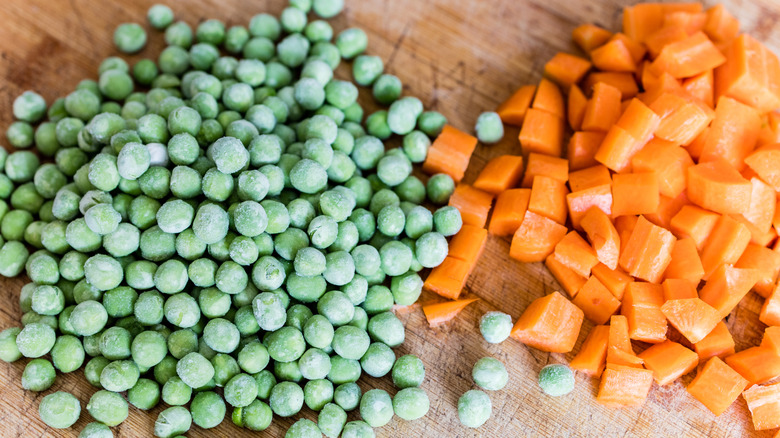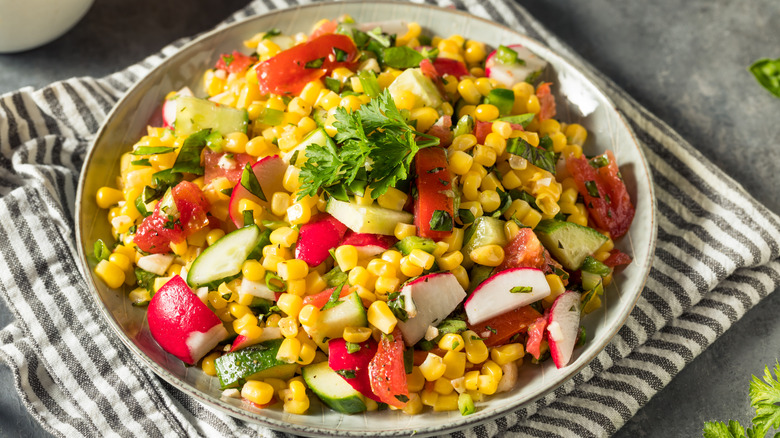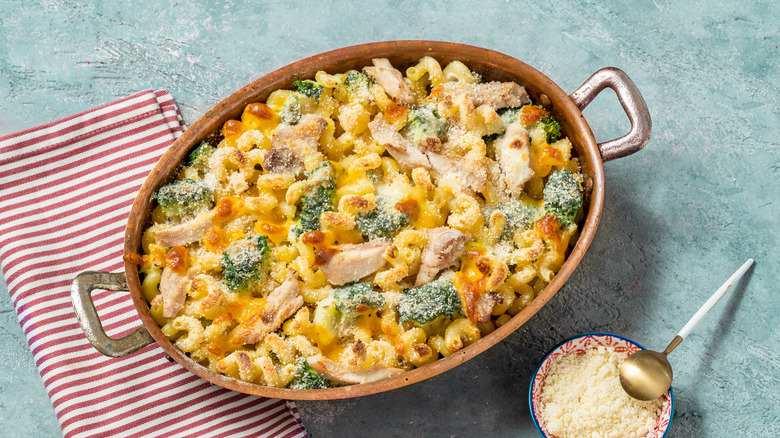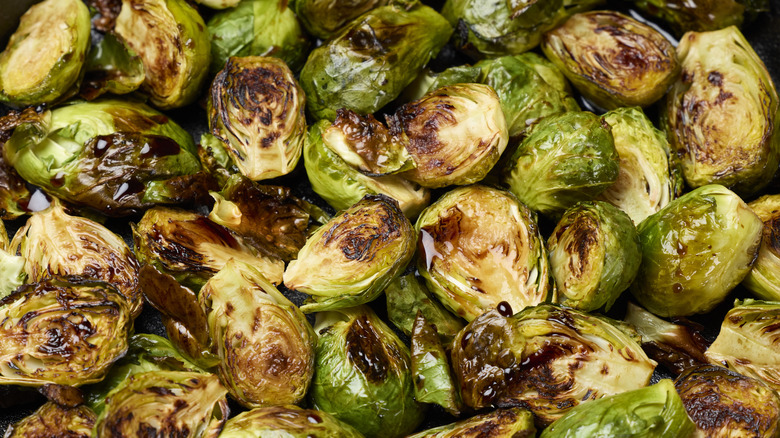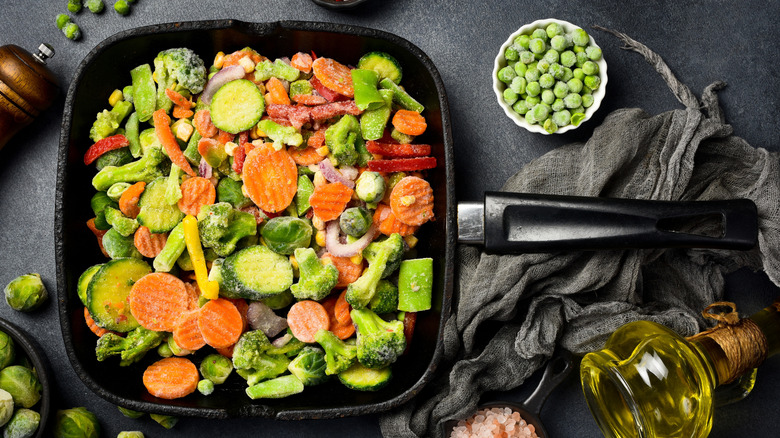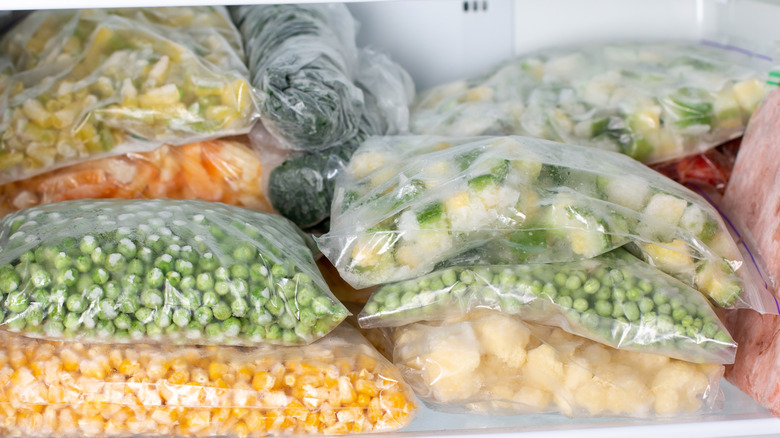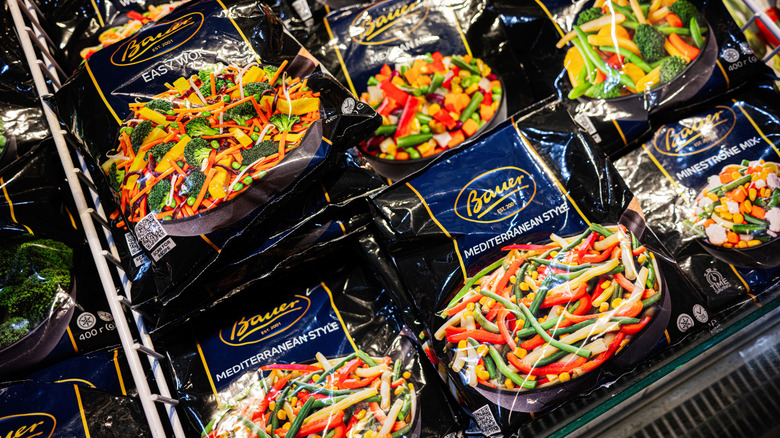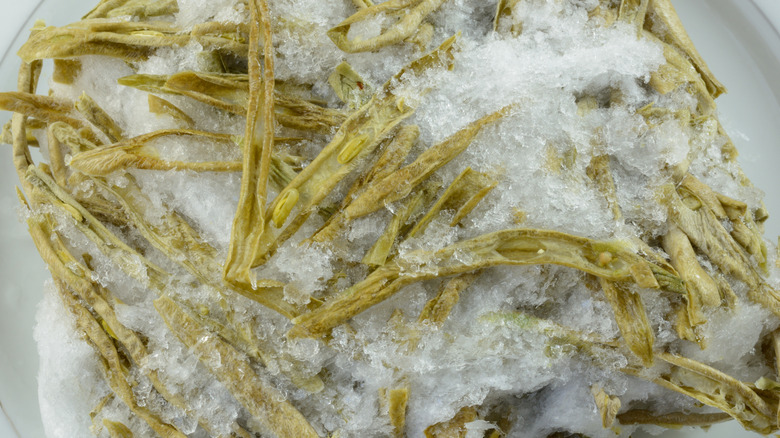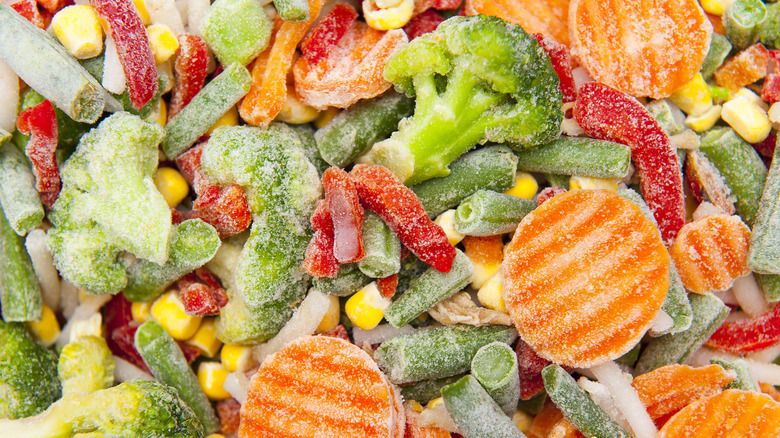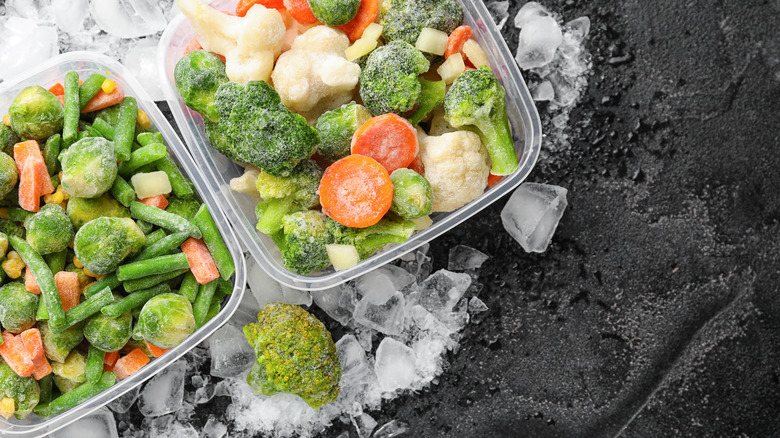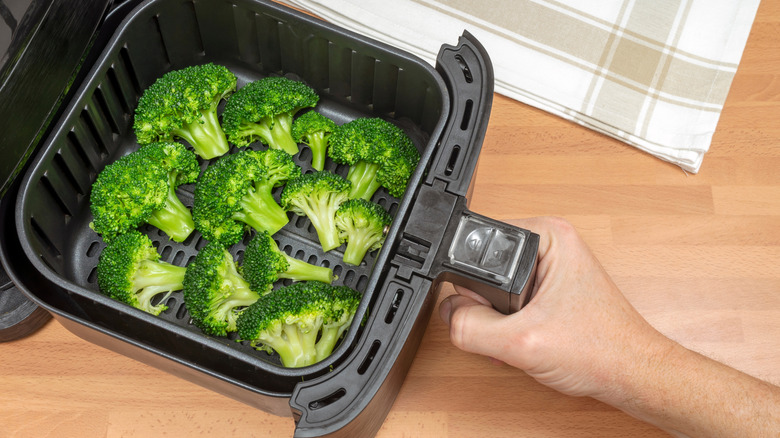Myths About Frozen Vegetables That Simply Aren't True
Let's be honest, there is nothing quite like freshly picked, in season vegetables. When it comes to flavor, texture, and overall quality, it is hard to beat a fresh green bean or broccoli spear. That said, vegetables aren't always in season, nor are they consistently available to everyone at any time. The next best option for those wanting to continue incorporating these healthy foods into their diets without breaking the bank is to lean on frozen vegetables.
A lot of folks have serious reservations about frozen vegetables that prevent them from purchasing these convenient and affordable staples. There are a number of myths, ranging from inferior quality to serious limitations in how they can be used, that simply aren't true. As a professional chef, I feel it is my duty to dispel these myths and rewrite the narrative.
Not only can frozen vegetables take meals of all kinds to the next level, they can be the secret weapon in the kitchen that you need to keep your family healthy and satiated. If you have shied away from frozen vegetables for any of these reasons, you will be surprised to know that they have a lot more going for them than you may have previously thought. Let me be the proverbial lighthouse to help you navigate the facts and fictions of the wondrous world of frozen vegetables.
Myth: Frozen vegetables aren't as nutritious as fresh ones
If you have ever wondered if frozen vegetables are as healthy as fresh ones, the short answer is yes. In fact, they can often be more nutritious. According to a 2014 study published in the Journal of Agricultural and Food Chemistry, frozen vegetables are not only as nutrient dense as fresh ones, they can sometimes exceed them. Unlike fresh vegetables that are sold at grocery stores nationwide, frozen ones are often harvested at peak ripeness and immediately frozen to preserve their color, flavor, and texture. Commercially grown vegetables are frequently harvested before they have ripened to prevent them from spoiling or becoming damaged during the transportation and distribution process. Vegetables do not reach their peak nutrition levels until they are fully ripe, which means these vegetables may not be as healthy.
What's more, the moment a vegetable is harvested, it begins to lose nutrients unless it is preserved in some way to prevent the deterioration process. By freezing vegetables picked at peak ripeness, the nutrients are essentially being locked in. The key is to look for those frozen vegetables that indicate they have been "flash frozen," "frozen fresh," "fresh frozen," "freshly frozen," or "just picked" on the packaging. Lastly, always select plain vegetables rather than ones that have seasonings or sauces added to them. These items often add unnecessary sodium, sugar, and fat to the vegetables that will inherently make them less nutritious than plain ones.
Myth: Frozen vegetables need to be cooked
A myth that is simply illogical and silly is that frozen vegetables always need to be cooked. When you pick or purchase fresh vegetables, you don't always cook them, so why should this rule apply to them when frozen? Although it is true that the texture, flavor, and digestibility of some frozen vegetables can improve with cooking, others are perfectly delicious, more nutritious, and have a better mouthfeel when used in raw applications, like salads, salsas, slaws, dips, smoothies, and more.
It is important to note that virtually all frozen vegetables have been previously blanched. The blanching process, which involves quickly par-cooking vegetables before shocking them in ice water to halt the cooking process, helps to improve their color, texture, and shelf-life. This means that they are ready to go, straight out of the bag.
Some of the best vegetables to use for raw applications are peas, corn, leafy greens, peppers, broccoli, and cauliflower. Before adding these to a recipe, it is important to thaw them so that they do not defrost in the dish, leaving behind excess moisture that can render salad or salsa waterlogged. To quickly thaw frozen vegetables, transfer them to a Ziploc bag and submerge them in cold water, swapping out the water every 30 minutes, until the vegetables are ready to use.
Myth: Frozen vegetables can be added directly to a casserole
One dish meals are a convenient and easy way to feed a large crowd. While frozen vegetables can be used for casseroles, they are not always the best option, at least not straight out of the packaging. Frozen vegetables can leach a lot of liquid into a casserole as it bakes, yielding a soggy mess that is difficult to serve and can leave much to be desired in the texture department.
There are a couple of ways around this to help mitigate some of the swampiness. First, it can help to pre-cook the vegetables to eliminate some of that excess moisture. Consider satuéeing, stir frying, roasting, or tossing them in the microwave for a few seconds, then draining off any resulting liquid that leaches from the vegetables. But don't overdo it. You don't want to cook them so long that they become mushy in the casserole. Instead, cook frozen veggies just long enough for some of that initial moisture to be drawn out of them.
Another great way to prevent frozen vegetables from weighing down a spruced-up green bean casserole or jazzed up baked mac and cheese is to add a filler to the dish. Ingredients like bread crumbs, French fried onions, nuts, cheese, crushed crackers or cereal, and rolled oats can help to absorb excess liquid and provide textural complexity. Just be sure not to go overboard on the filler. It shouldn't detract from the vegetables but enhance them.
Myth: Frozen vegetables can't be roasted
There is a pervasive myth that frozen vegetables cannot be roasted. While it is true that the freezing process does alter the cellular structure of vegetables somewhat due to the formation of ice crystals, which can make roasting trickier, it can and should be done. That said, there are some tips and tricks that must be followed in order to achieve that caramelized, sweet, crisp quality that makes roasted vegetables so desirable.
First, not all vegetables are ideally suited to roasting. The best options are those that are inherently lower in moisture content and lend themselves to caramelization. Good contenders include cruciferous veggies, like broccoli, cauliflower, or Brussels sprouts, and root vegetables, including butternut squash, carrots, and sweet potatoes. When selecting vegetables, make sure they are roughly the same sized pieces, so that they do not cook unevenly.
The other key to roasting frozen vegetables is to properly prepare the baking pan you are using and to employ high heat. Start by greasing a baking sheet liberally with an oil that has a high smoke point and placing it in the oven until it is piping hot. This will ensure the vegetables begin cooking immediately. The ideal temperature for this process is approximately 450 degrees, which will encourage the commencement of the Maillard or browning reaction and prevent the vegetables from steaming. Lastly, make sure to stir the vegetables routinely to prevent them from burning on one side.
Myth: Frozen vegetables aren't as flavorful as fresh ones
When it comes to the flavor of frozen versus fresh vegetables, there is often a perception that they won't taste as good as fresh ones. This is frequently not the case, especially if you don't grow your own or purchase freshly picked vegetables from a farmer's market. Store-bought vegetables often lack any flavor, being an almost cardboard-like facsimile of what you anticipate that vegetable tasting like. Again, this is because many vegetables are harvested before they have fully ripened to prevent spoilage and degradation during transport and distribution.
While some vegetables and fruits can and will ripen after harvest, others will not. This is the difference between climacteric and non-climacteric vegetables and fruits, or those that are ethylene sensitive versus not. Climacteric vegetables will continue to release ethylene gases, which will enhance ripening after they are picked, while non-climacteric ones do not. Because frozen vegetables do not need to be protected from the ravages of the transportation and distribution process, they are always picked at peak ripeness and immediately frozen, which means they are preserved at optimum taste and quality. A good rule of thumb to consider when deciding whether to use fresh or frozen vegetables for maximum taste is whether or not that vegetable is climacteric or non-climacteric. If you are unable to get farm-fresh, just-picked broccoli, corn, or potatoes, for example, you may want to opt for the frozen variety for best flavor.
Myth: Frozen vegetables need to be thawed before cooking
Another myth about frozen vegetables is that they have to be thawed before they can be added to a dish. One of the advantages of frozen food in general, particularly vegetables, is that they can be cooked from a frozen state without thawing. In fact, this is often advisable for the best quality flavor, texture, and visual appeal.
Vegetables are frozen with the intent that they can be added directly to a dish and then quickly reheated until they have thawed and are just al dente in texture. If allowed to thaw before cooking, they often become overcooked and mushy, which is not only unappetizing, but it can result in serious nutrient loss. Additionally, they will lose their vibrant hue, resulting in something that looks unappealing. Perhaps the only time frozen vegetables should be thawed before use is if they are added to a finished dish and will not be cooked further. Otherwise, always add frozen vegetables to a recipe in their frozen state, unless specified to the contrary.
Myth: Frozen vegetables always contain preservatives
This myth is perhaps a valid one, depending on the product. It is true that some frozen vegetables do contain preservatives, such as salt, sugar, or other additives that can enhance color, taste, and extend shelf life. That said, the freezing process itself is a natural preservation technique, so plain frozen vegetables without any seasonings or sauces added to them should be preservative free.
The exception to this is any frozen vegetable product that comes with a sauce, gravy, or seasoning packet, along with products that has been pre-cooked or prepared in any way. Examples of this might include cheesy broccoli or Asian-style stir-fried vegetables with a teriyaki sauce. To ensure the frozen vegetables you are buying are sans preservatives, purchase organic ones or those that are labeled "no preservatives," "no artificial preservatives," or "preservative free."
If you still aren't certain, always buy plain, frozen vegetables and season them or make a sauce yourself. This will guarantee that anything you add to the veggies meets your standards and you know exactly what you are ingesting. It will also often result in food that is more flavorful and less salty.
Myth: Frozen vegetables cannot be consumed beyond their best if used by date
We have all discovered an old package of frozen corn or peas lurking in the back of our freezer that appears to have been there since the Stone Age and has a "best if used by" date that is at least a couple of years old. It may not look particularly appetizing, but, despite its antiquity, this package of frozen vegetables can still be used for more than just nursing that pulled muscle in your back.
According to the USDA, food that has remained frozen is safe to eat well past its date label, as the pathogens that cause food poisoning cannot grow in the freezer. Most frozen vegetables are labeled with a "best if used by" date on the package. These are not expiration dates but simply an indicator of when the product will be at its peak quality, as long as it has been properly stored.
The best way to prevent freezer burn is proper storage. Before using vegetables in a recipe, search for any signs of freezer burn or damage to the packaging that might compromise quality beyond the point that the vegetables are consumable. Even then, I tend to be selective with where to use these more antiquated frozen vegetables. They may be best reserved for soups, stews, or puréed into a smoothie rather than as a component for a salad or a stir fry, where their texture and shape may be too far gone to shine.
Myth: Frozen vegetables should all be cooked for the same length of time
Among the more absurd myths is that any frozen vegetable can just be tossed into a pan and cooked to perfection at the same time. You would never do this with fresh vegetables and you cannot do it with frozen ones either. All vegetables have their own unique characteristics that impact how long it may take to cook to perfection. Factors such as density, cellular structure, and moisture content can all impact the speed at which a particular vegetable will cook, fresh or frozen. For example, zucchini, which is made up of about 95% water by weight, cooks extremely quickly, while sweet potatoes, which have a moisture content of between 60 and 80%, will take a longer time to soften.
The speed at which a vegetable cooks will also be contingent upon its size. Smaller cut vegetables will cook faster than larger ones because more of the surface area is exposed to heat, which will help to break down the cellular structure more rapidly. As such, fragile frozen vegetables with a higher moisture content should always be added toward the end of the cooking process so that they do not get mushy and overcooked, while more durable, lower moisture content ones can be added earlier on.
Myth: The freezing process kills bacteria
While bacteria cannot grow in the freezer, it does not actually die in subzero temperatures, contrary to popular belief. According to the USDA, freezing vegetables to 0 degrees Fahrenheit will render microbes, such as bacteria, yeast, and mold, inactive, but the moment these are thawed, they will once again begin to proliferate. This is why it is crucial to keep vegetables frozen solid until you are ready to use them.
If you freeze produce yourself, the best way to mitigate the presence of microbes is to clean it thoroughly before doing so. All vegetables should be rinsed in cold water before freezing. Note that some vegetables will require a bit more effort to clean. Those with abundant nooks and crannies can retain soil and dirt that can only be removed by soaking the vegetables in water for several minutes. And, if you plan to consume the skin of produce like potatoes or carrots, the skin should be well-scrubbed with a sanitized vegetable brush before it is eaten.
Another tip to reduce the presence of microbes in vegetables is to remove any blemishes, like bruises or cuts, from the surface of the produce before freezing, as these can be breeding grounds for bacteria. Lastly, if you are still concerned, you can soak the vegetable in a baking soda or vinegar solution, but be mindful of how long you leave delicate vegetables in the wash, as they can begin to break down with these harsh acids.
Myth: Frozen vegetables cannot be cooked in the air fryer
While it may seem like frozen vegetables would be too delicate to throw in the air fryer, this is far from true. In fact, vegetables are among the best frozen foods to use in the air fryer, which is essentially a tiny convection oven. The even heat will render the vegetables perfectly crisp and browned as long as you use the right ones and pay close attention to how you roast them.
Frozen vegetables are especially well suited to an air fryer because they are a little more forgiving. They won't burn to a crisp in an instant because they take a bit longer to heat through. That said, you should still be mindful as to which ones you use. Cruciferous vegetables, green beans, corn on the cob, and even carrots can turn out beautifully, while those that retain a lot of moisture, like kale or spinach, are a disaster waiting to happen.
When air frying frozen vegetables, you will want to do so in small batches, layering them evenly along the bottom of the basket. Toss the vegetables in oil and your favorite seasonings before placing them in the air fryer. Make sure to shake the basket halfway through the cooking process to encourage even cooking and eliminate any excess moisture.

